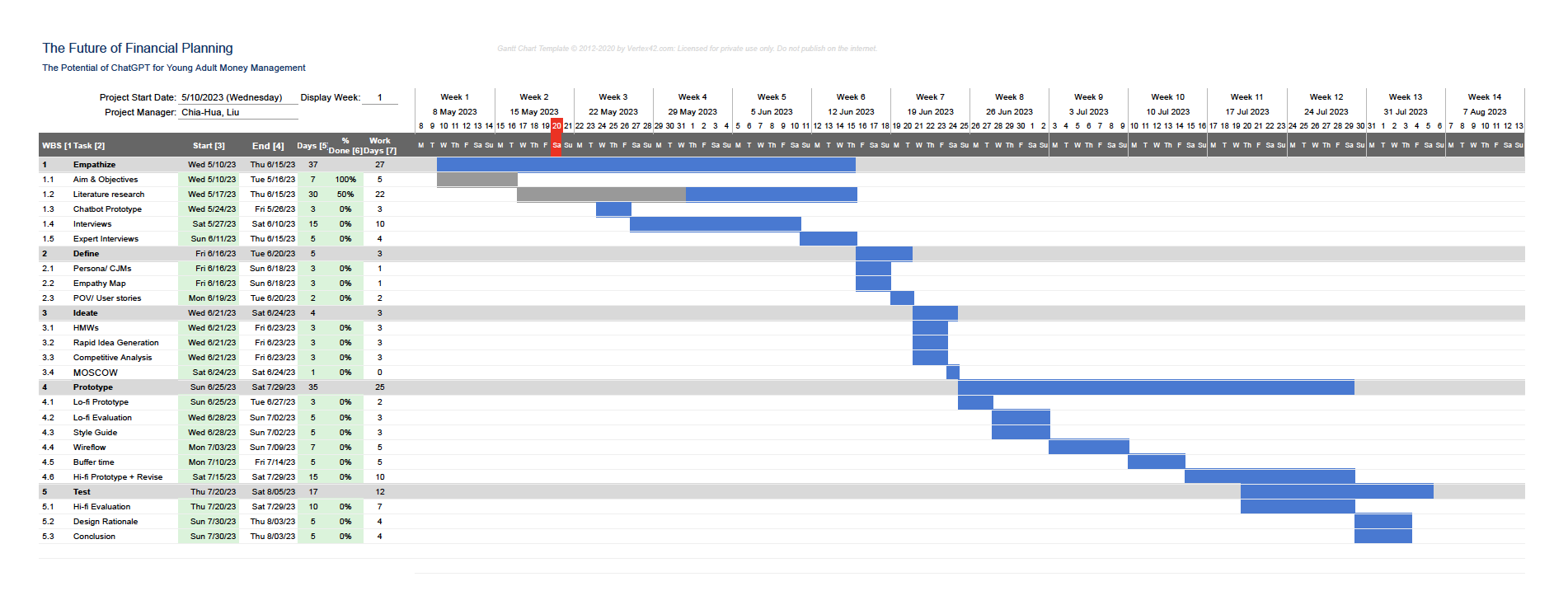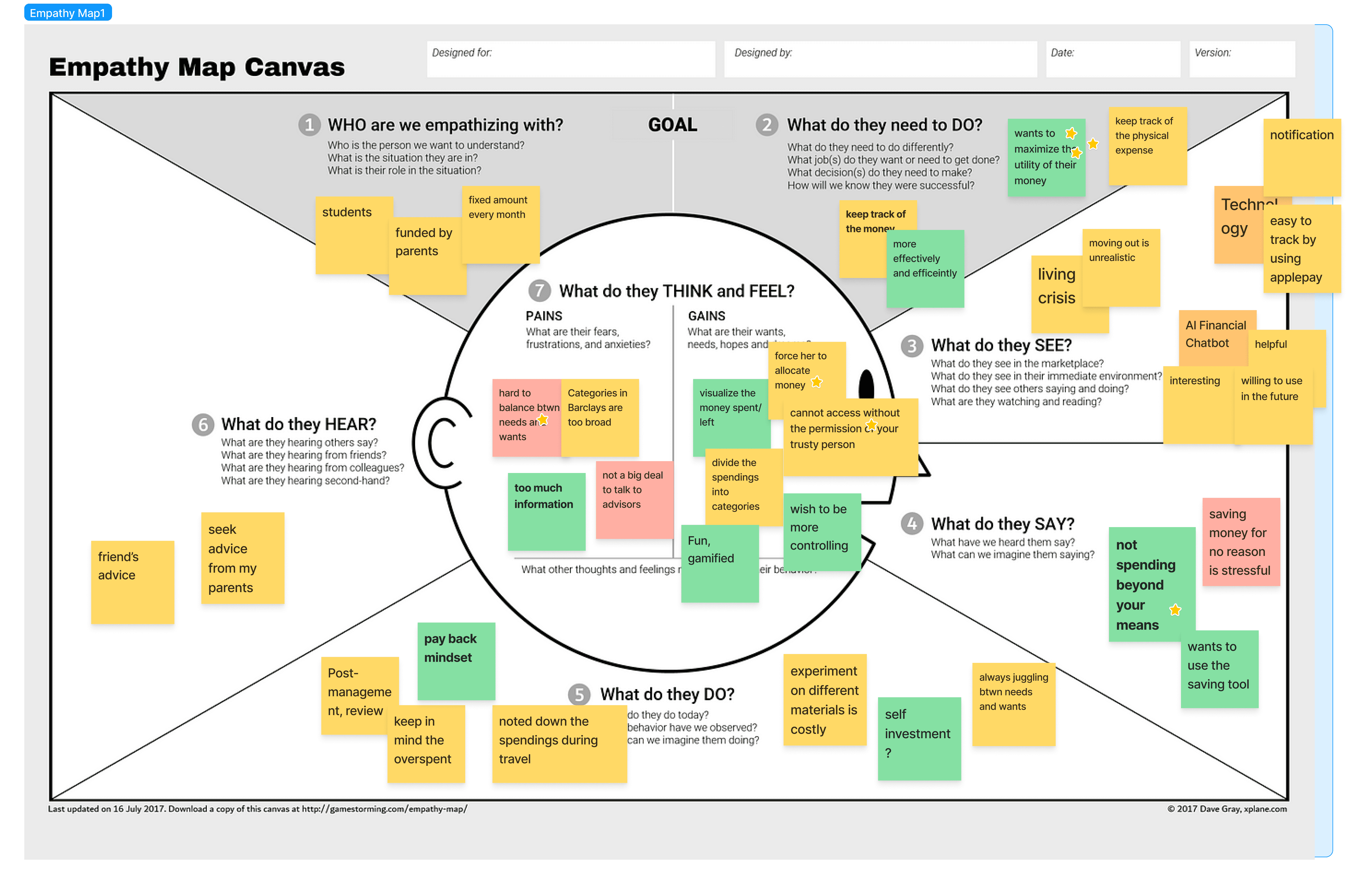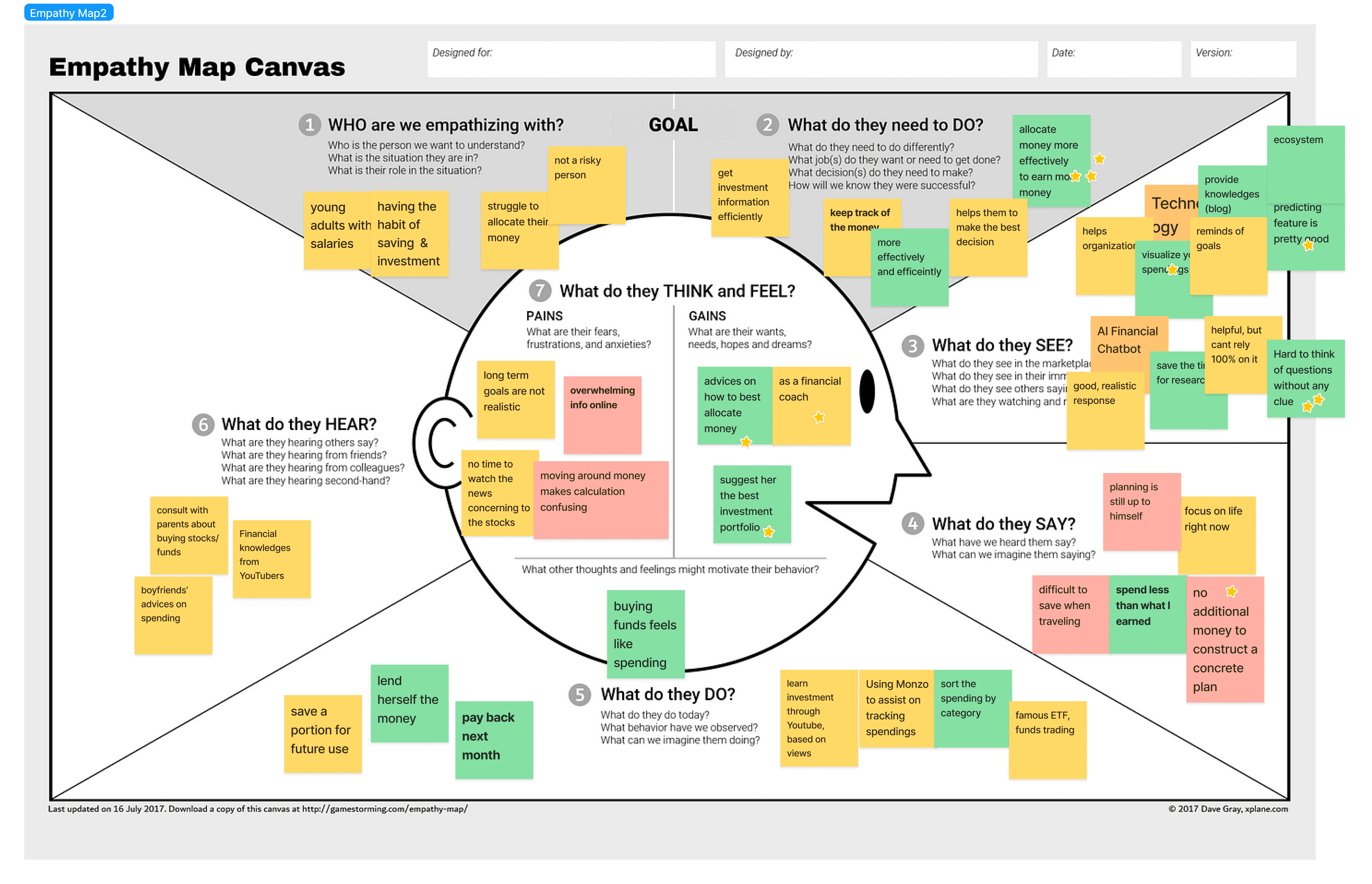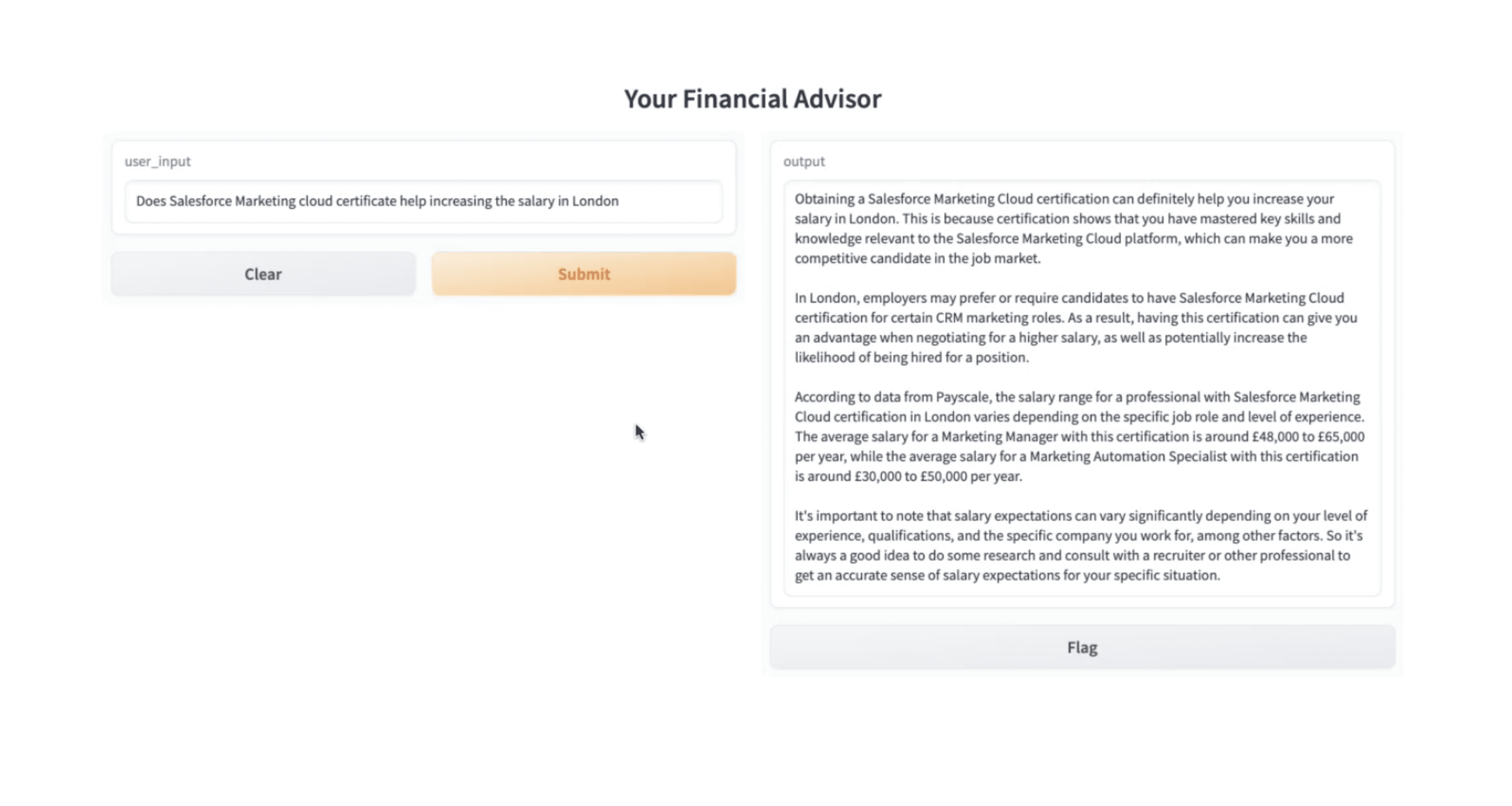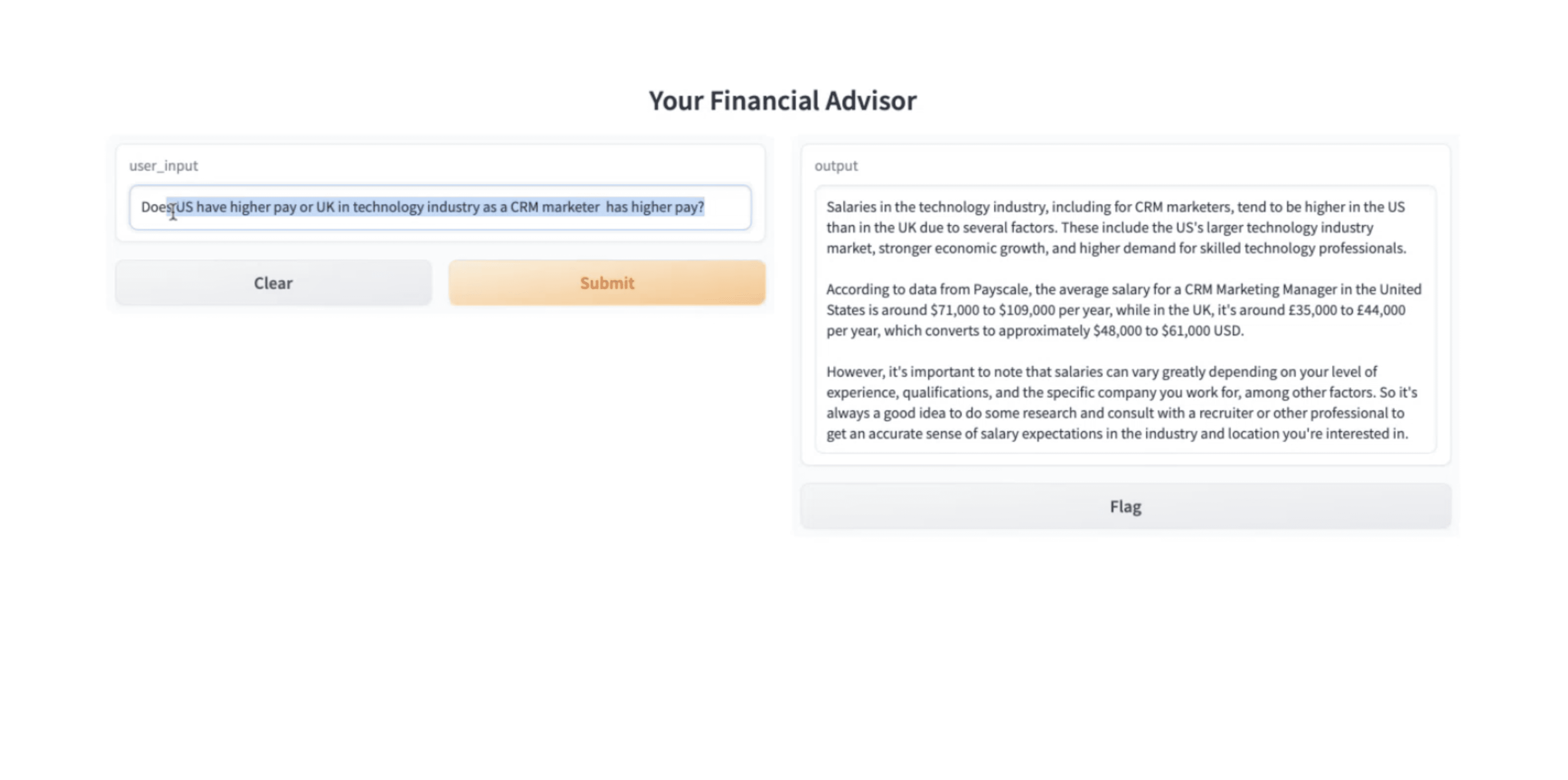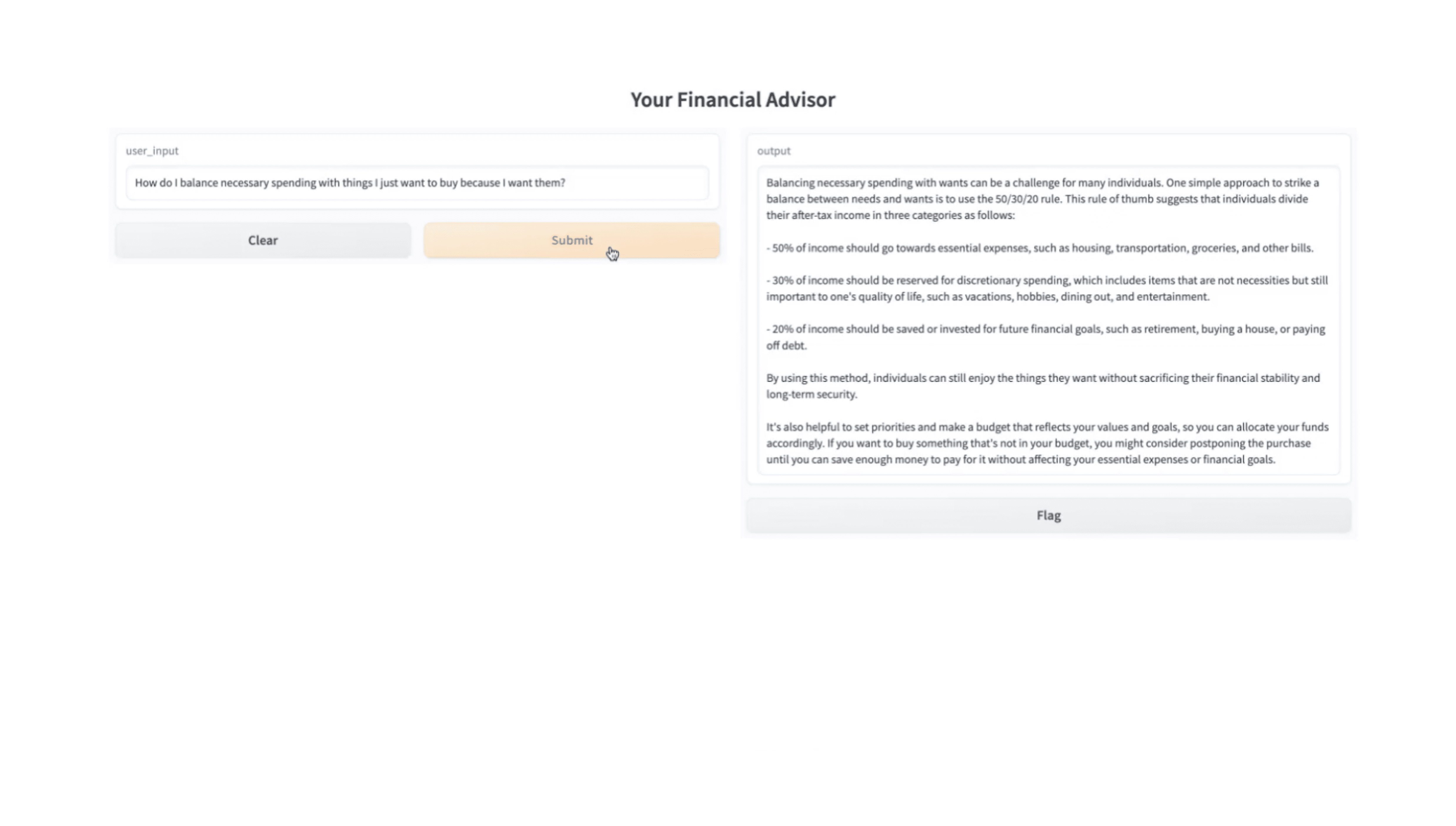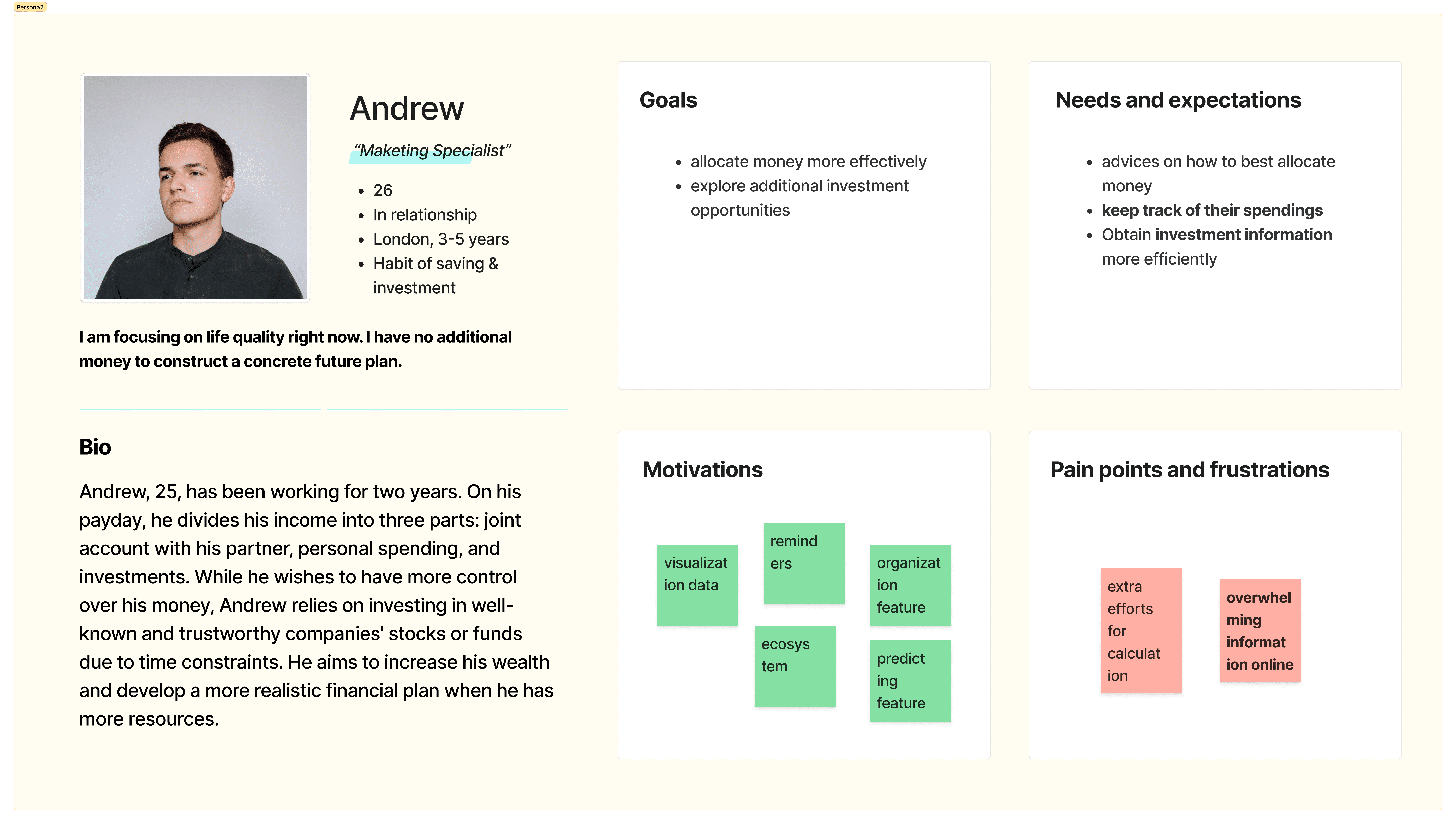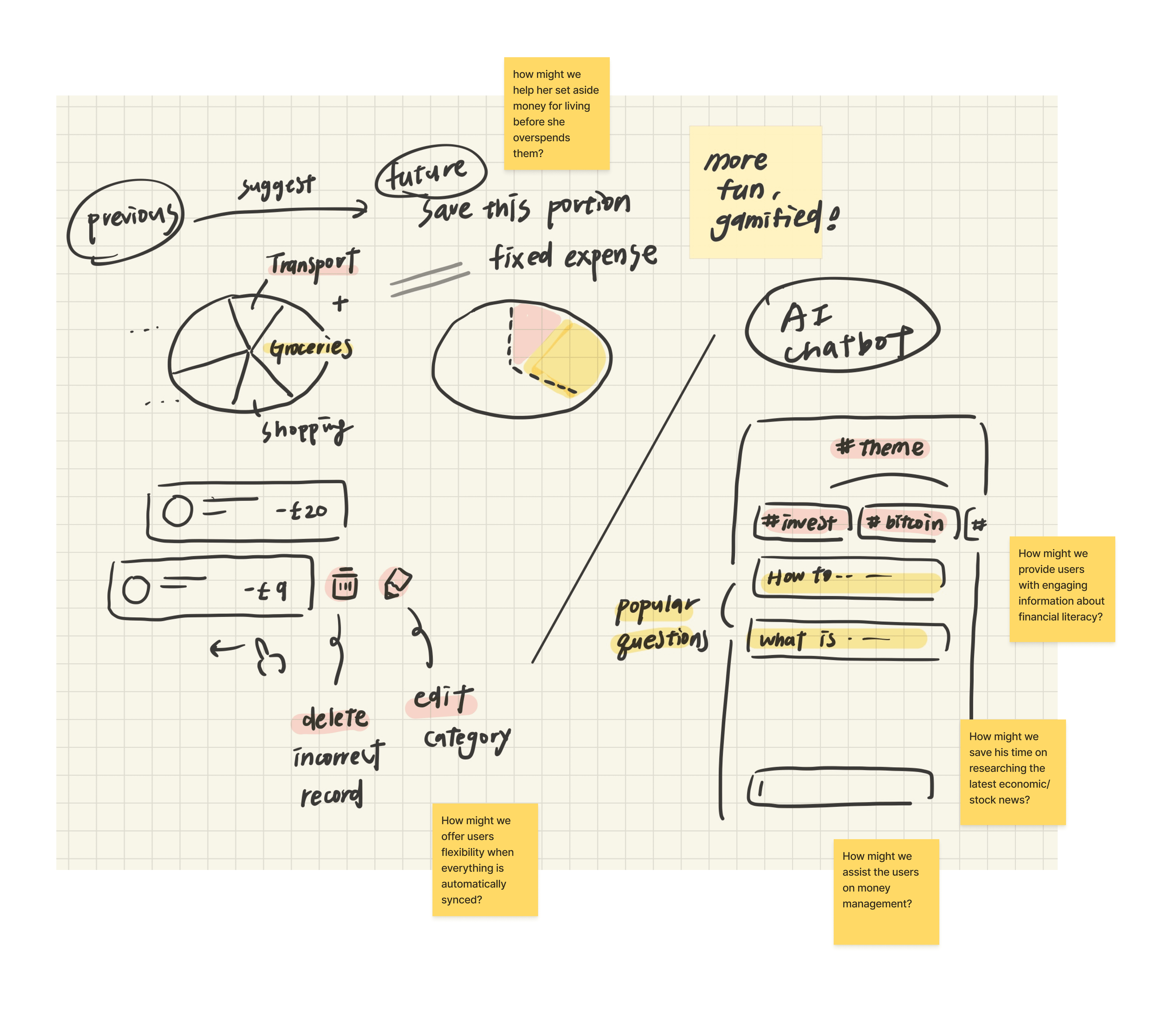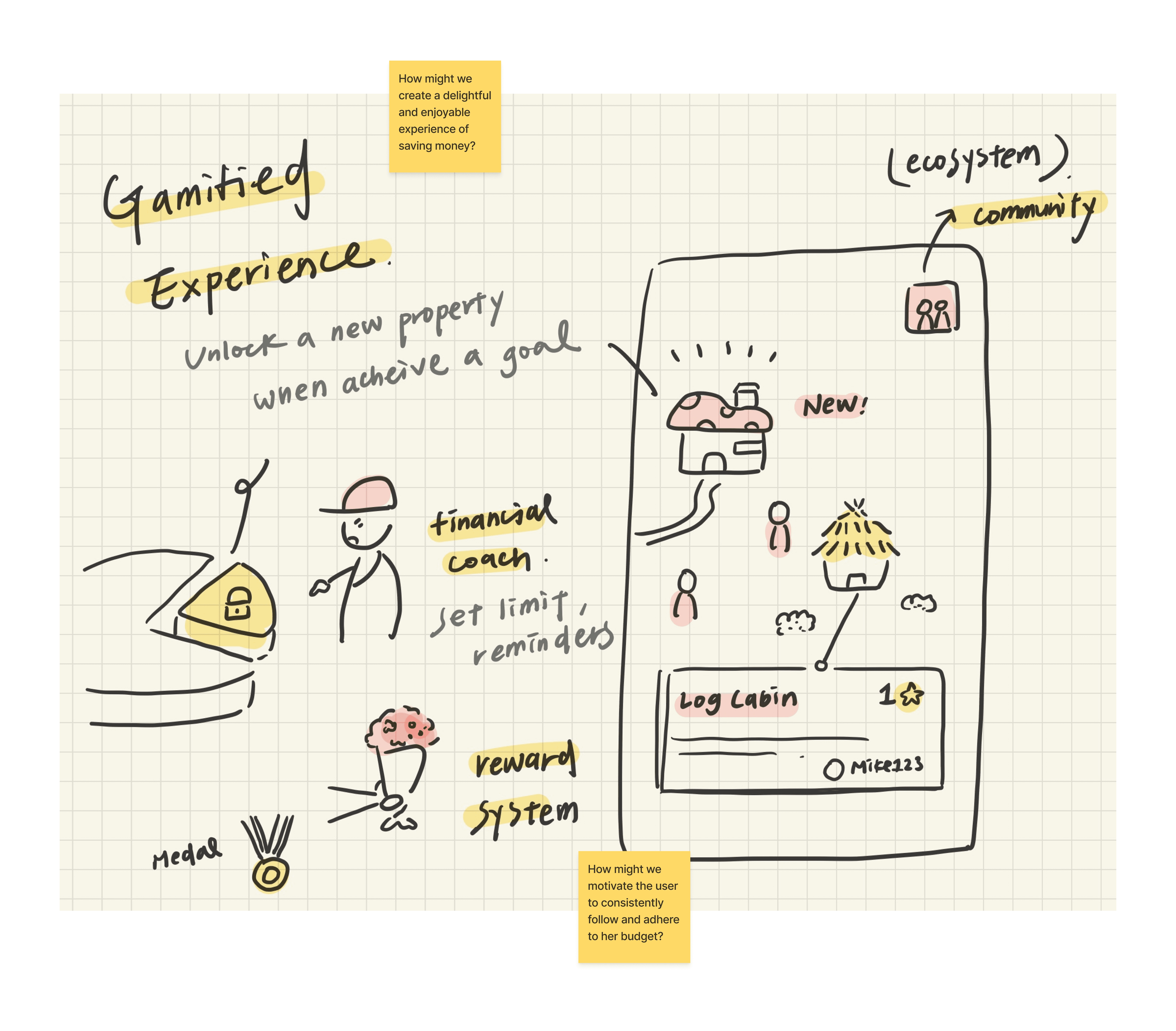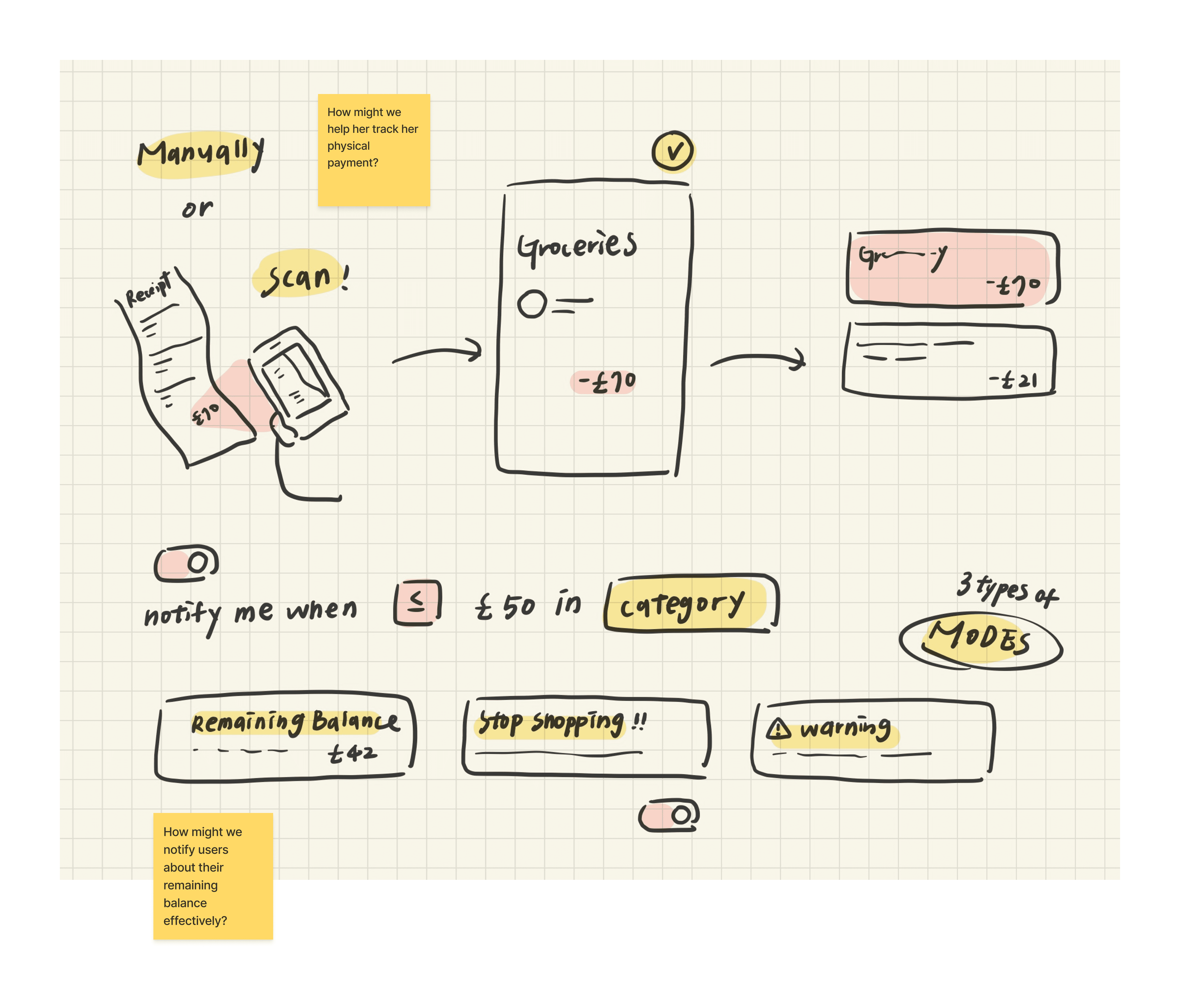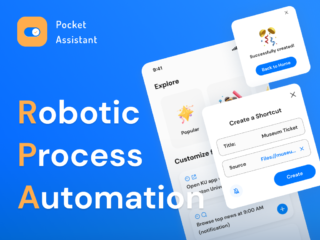About
The aim of this project is to research and design an application that will assist the users on building a sound money management habit. And explore the potential of utilizing ChatGPT to provide effective financial advice. Building upon the findings from previous research, the goal is to ideate a solution that caters to the specific requirements of young adults, helping them understand and improve their financial habits.

Background Research
Establishing sound financial habits early on in life can benefit individuals in the long run. However, because of things like high student debt and other complex issues we’ll explore further in our user research, it’s tough for young adults to make saving and investing a priority. To deal with this challenge, we’re considering the potential of technology to come up with a solution. In this literature review, our goal is to look into existing research about possible technologies, especially AI Chatbots, to gain insights from related research.
Aim & Objectives
- Gain insights into the behaviour and needs of young adults when it comes to financial management
- Explore the potential of utilizing ChatGPT to provide effective financial advice
- Ideate a solution that caters to the specific requirements of young adults (18-30), helping them understand and improve their financial habits
Research
Technology Research
The rise of AI chatbots, powered by Natural Language Processing (NLP), is transforming the financial industry. These chatbots can engage in conversations that feel like interacting with humans, offering real-time responses, gathering data and providing personalized assistance. Their usefulness extends to various sectors beyond finance. In the financial realm specifically, they serve as valuable resources, helping users understand different financial products and services.
To make them effective, it’s crucial to understand user intentions and preferences while ensuring compatibility with their daily routines. Furthermore, these chatbots have the potential to offer financial guidance through robo-advisors. These robo-advisors are capable of analyzing individual account balances, setting goals for users and optimizing budget allocations accordingly. By combining AI chatbots with robo advisors in this way, individuals can gain the knowledge needed to make well-informed financial decisions based on insights derived from a comprehensive analysis of user behaviour.
**For more detailed research, my dissertation will be released in January 2024 so stay tuned!**
Research
User Interview
Conducting user interviews is a valuable way for researchers to gather information about the project’s requirements and gain insights from the intended users. These face-to-face interactions provide an opportunity for researchers to delve into topics in-depth, gaining a better understanding of users’ needs within the specific context.
Interview questions focused aspects:
- Users’ cognition toward financial management
- Users’ experience of using financial tools/ seeking financial advisors
- Users’ intention of engaging with financial AI chatbot (after evaluation)
After coding the transcripts of user interviews, we can use an empathy map to organize and analyze the valuable insights shared by the participants. The empathy map acts as a helpful tool that allows us to move from raw interview responses towards gaining a deeper understanding of the emotions, perspectives and behaviours of the individuals involved.
Empathy maps
Research
AI Chatbot Evaluation
To enhance direct user interaction with a financial chatbot, we conducted research on creating a personalized AI chatbot. We effectively developed a demonstrative AI chatbot using the open-source code from AI Advantage. The chatbot comes equipped with user-friendly input and output features and can be accessed on both desktop and mobile platforms. By incorporating the OpenAI GPT 3.5 model, the chatbot stands out as a distinct financial advisor.
During the AI chatbot evaluation, participants were encouraged to interact with our financial AI chatbot by asking any finance-related queries. This allowed us not only to observe their interactive behaviour but also to provide valuable insights for future fine-tuning.
Examples of users’ engagement with AI chatbot
Define
Personas
From the preceding phase, it becomes evident that the empathy map embodies two distinct personas. In order to enhance the ability to empathize with our users, we have developed two personas, each accompanied by a concise biography, goals, motivations, and points of frustration.
When we examine the two personas closely, a clear difference stands out: people with a consistent income are more inclined to think about investing and planning for the future, whereas individuals with limited financial resources, primarily students, focus on making the most of their money. Despite these variations, both personas share a common need for help in keeping track of their spending. Additionally, they both feel overwhelmed by the sheer volume of financial information available to them.
When we consider the solutions that can meet the needs of both personas, we notice an interesting thing; Persona Emily is likely to find herself in a situation similar to persona Andrew’s as she begins to earn money. This realization emphasizes how user experiences are interconnected and evolve over time. Therefore, our main focus should be on creating an application that effectively addresses the changing requirements of both personas.
Define
Point of Views
To enhance the accuracy of our insights, we have condensed these opportunities into Points of View (POVs). Each POV represents a distinct user requirement, enabling us to concentrate closely on these insights as we move towards the ideation phase.
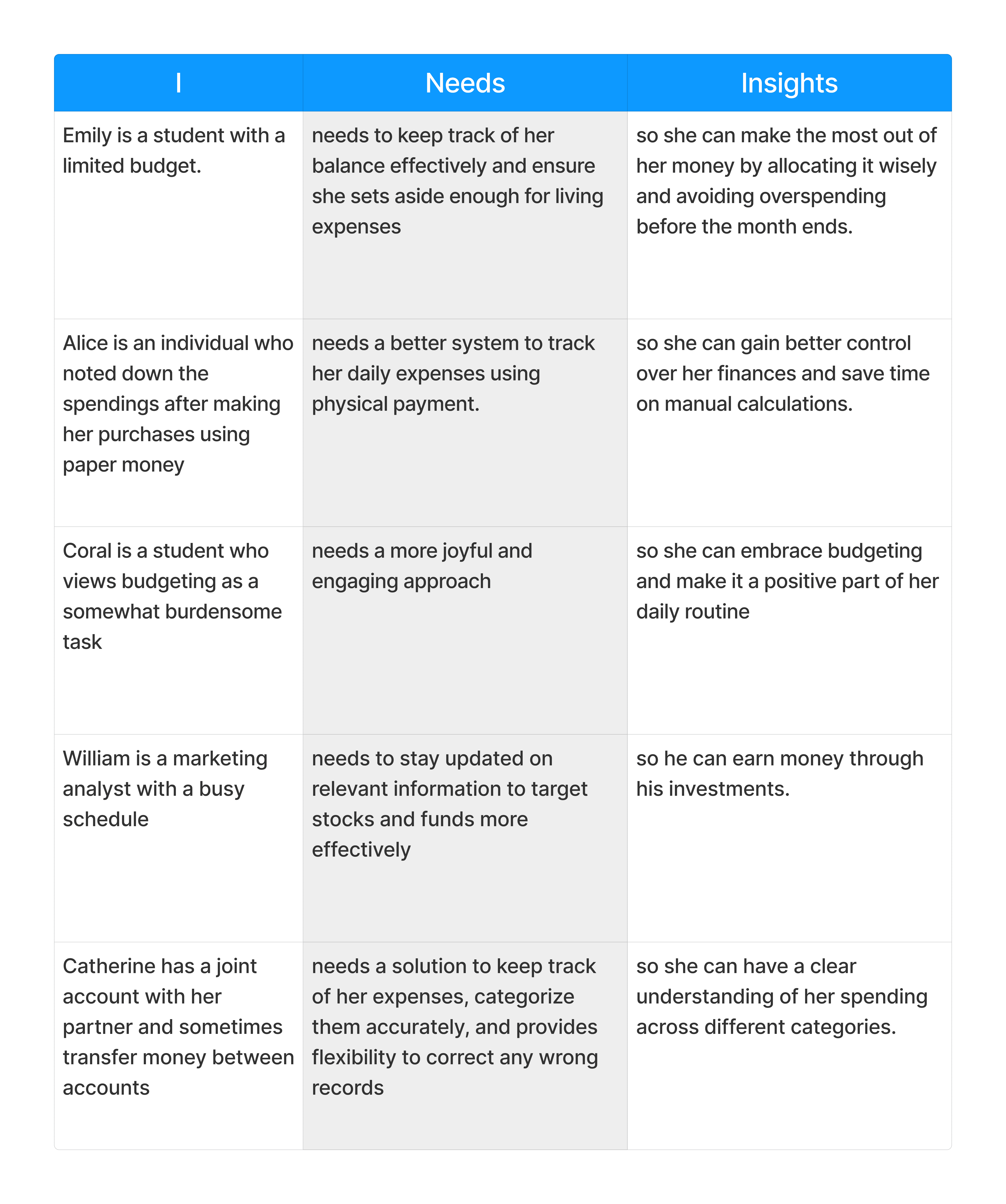
POVs
Ideate
Rapid Idea Generation
Based on the HMW questions, numerous ideas were rapidly generated within a constrained timeframe. Subsequently, the idea that seamlessly aligned with the HMW questions was identified. These selected ideas were marked as possible solutions by attaching a sticky note next to them.
HMW questions:
- How might we help her set aside money for living before she overspends them?
- How might we create a delightful and enjoyable experience of saving money?
- How might we motivate the user to consistently follow and adhere to her budget?
- How might we help her track her physical payment?
- How might we save his time on researching the latest economic/stock news?
- How might we offer users flexibility when everything is automatically synced?
- How might we assist the users on money management?
- How might we notify users about their remaining balance effectively?
- How might we provide users with engaging information about financial literacy?
- How might we make the interface simple but essential?
Sketches of rapid idea generation
Design
Lo-fi Prototype
To enhance the idea’s clarity and substantiate its viability with user feedback, a low-fidelity prototype was created, encompassing key features: Analytics, Robo-advisor, and the Reward system.

Lo-fi Prototype
Evaluate
Exploratory test
An exploratory test is employed to assess the effectiveness of a design in addressing users’ needs. In this study, five users were invited to participate in two separate exploratory tests with a lo-fi prototype.
“Three to five users were selected for most of our evaluation due to the cost-efficient way to get the most optimal results that are similar to testing with 15 users.”
– Nielsen’s studies on <Why You Only Need to Test with 5 Users>
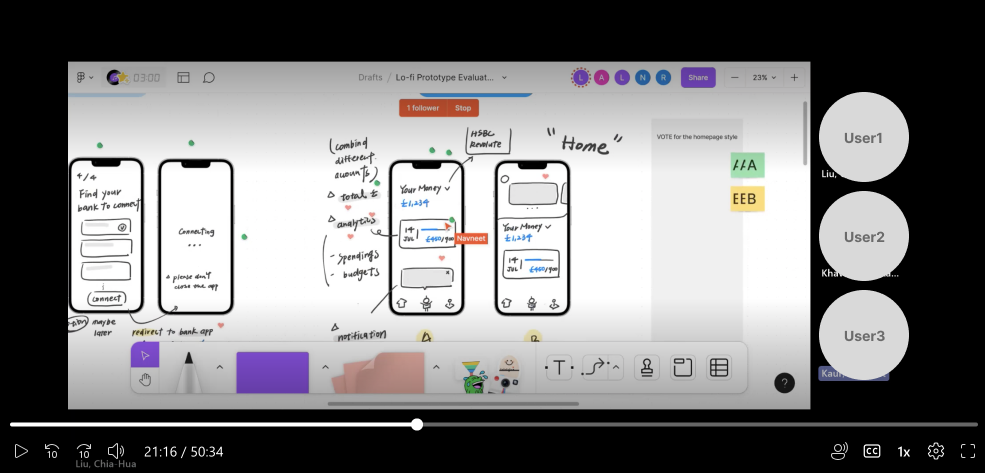
Screenshot of the exploratory testing
Key insights:
- Users expressed the desire for added security through two-factor authentication when opening the app to protect their accounts.
- Users indicated the convenience of having an overview of all their accounts on the homepage for quicker access and efficient management.
- Users expressed interest in the option to track their account balance over specific periods, such as vacations, to better handle their finances.
- Users would find it valuable if the Robo-advisor feature could tailor information based on their experience level, ensuring more relevant insights.
- Users mentioned that a premium subscription option in the Reward system would allow them to customize goals and discourage misuse for rewards.
Design
Mid-fi Wireflow
After confirming the feature concepts, the next phase involves crafting an inclusive wireframe encompassing all user flows. The mid-fidelity wireframe primarily serves the purpose of functionality testing.
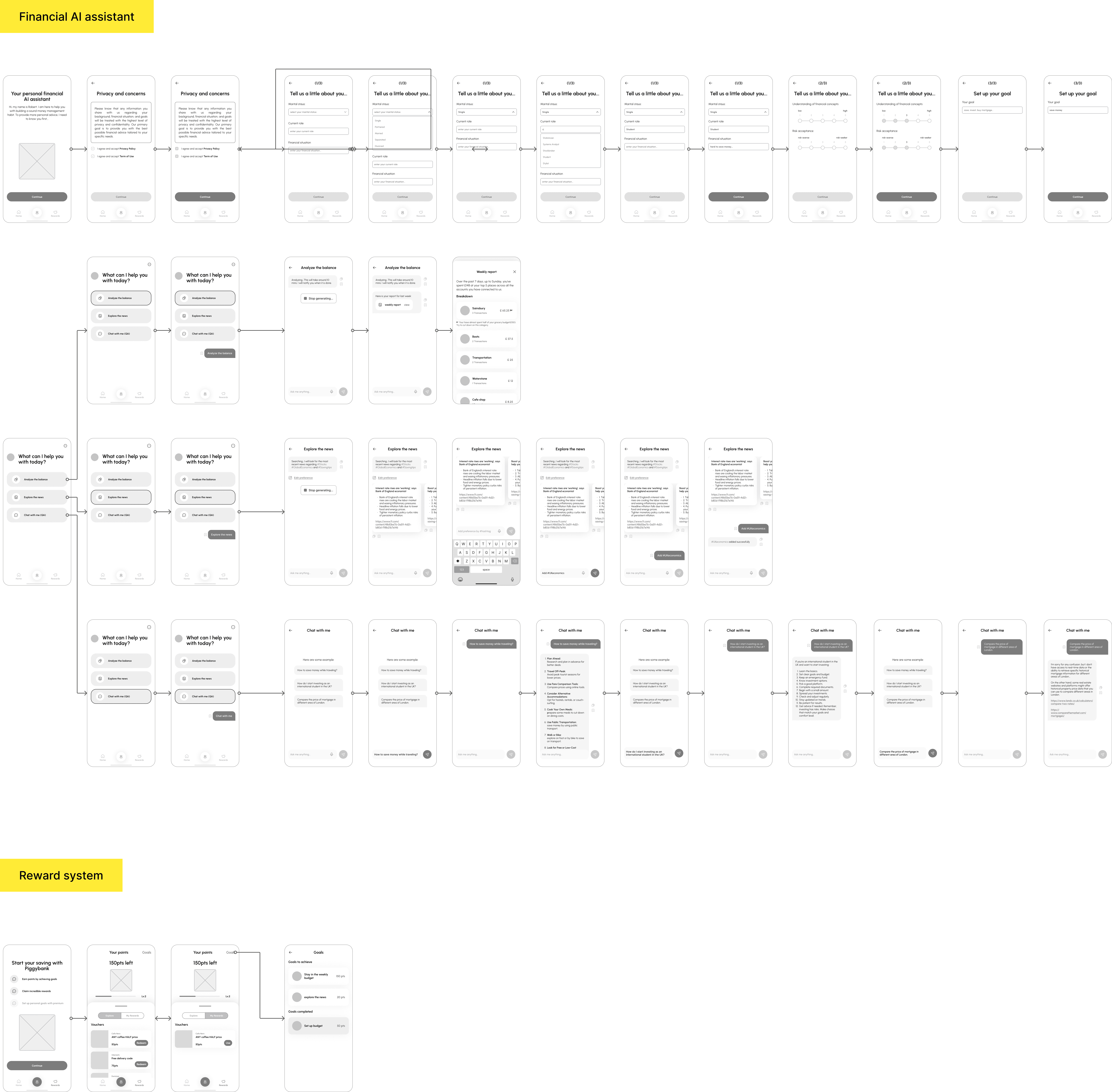
Part of the mid-fi wireflow
Style Guide & Design System
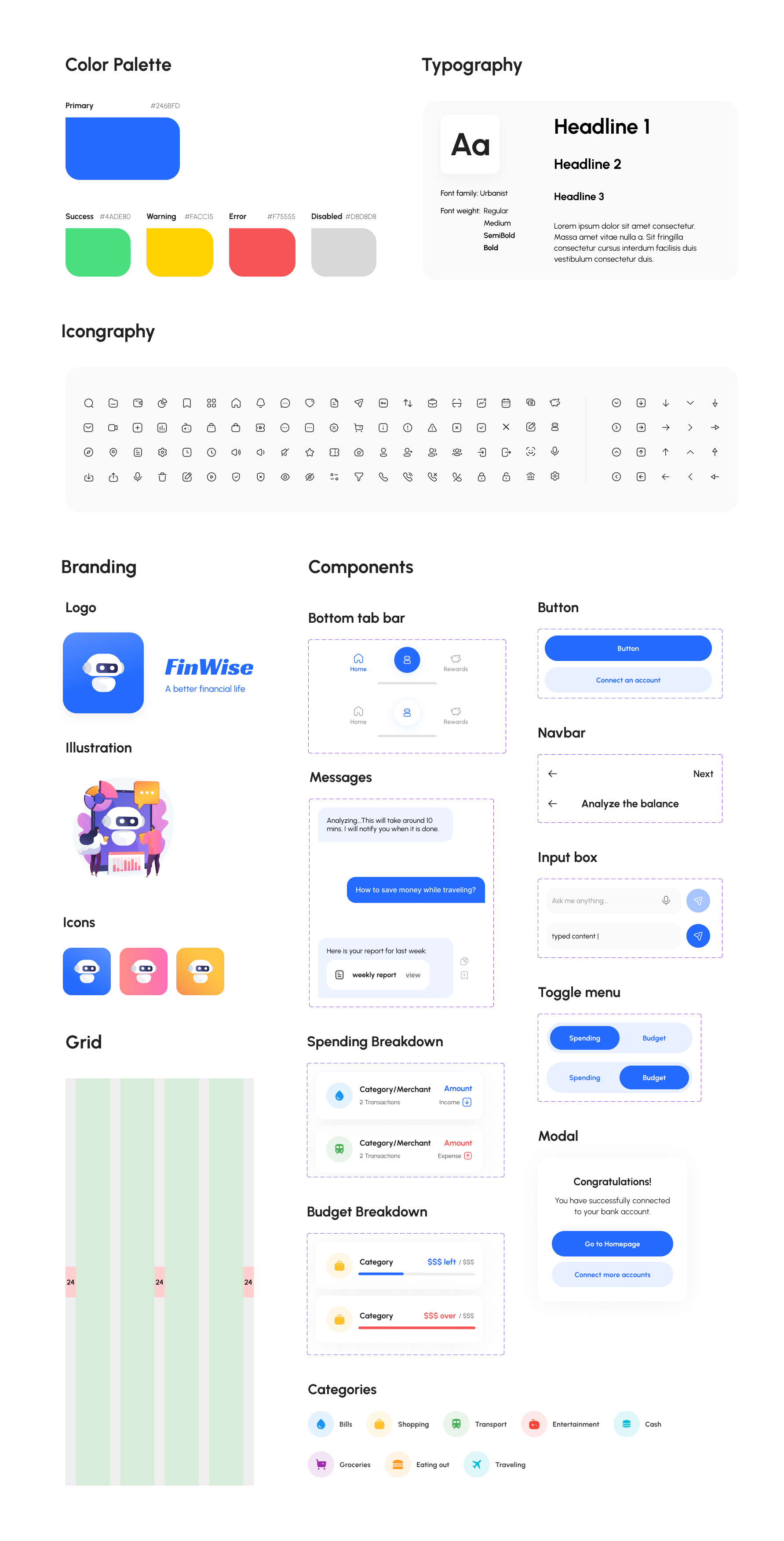
Design
Hi-fi Prototype
In this high-fidelity prototype, we’ve enhanced the onboarding experience to empower users to explore the app’s functionalities before setting up their accounts, giving them an initial overview of what features are available. Moreover, we’ve improved the clarity of the featured functions during the onboarding process by mapping out key features and replacing illustrations with screen highlights. Recognizing the importance of social presence in user interactions, we’ve refined the personalization process of the AI assistant to emulate real interactions between customers and financial assistants.
Interactive Prototype:
Future work:
Regarding future development, valuable insights derived from user feedback during the evaluation of the hi-fi prototype have shed light on avenues worth further exploration. These possibilities include investigating the feasibility of integrating investment accounts, enhancing the presentation of analytics and incorporating insights gathered from the user community. Each of these areas holds great potential for progress and expansion.




